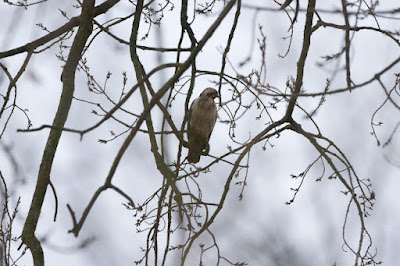A mild, wet month of mostly grey days. Late winter flowers sprouted and bloomed, heralding the succession of wild flowers that will bloom on through to summer.
Three times as much rain has fallen as would be expected for this time of year in Norfolk.
Birds chased one another, territorial or in pursuit of breeding. More species started to sing.
Hares, rabbits and pheasants were seen quite regularly.
 |
| Sunset, garden. Blackbird singing. |
 |
| Mixed flock of Common and Black-headed Gulls on the lake |
 |
| Hellebore, garden |
 |
| Crocuses and snowdrops, garden |
 |
| Little Egret |
 |
| Grey-blue water, blue skies |
 |
| Cloud sheet moving away at sunset |
 |
| Kestrel |
 |
| Sparrowhawk, garden |
 |
| Mixed swan herd on a flooded field in east Norfolk |
 |
| Primarily Beswicks swans |
 |
| Primarily Whooper swans |
Not only were fields flooded, but also some minor roads. This meant either a determined drive through floodwater, a clunky three-point turn and retreat, or a careful reversing-away to find an alternative route.
 |
| Flooded view from the main observatory, Welney WWT |
 |
| Pochard, Mallard, Scaup |
 |
| Bottoms up! |
 |
| Whooper swans |
 |
| Lady Fen, Welney |
 |
| Cattle Egret, without cattle |
 |
| Lapwings, Golden Plover |
 |
| Swans on the fields |
Swans are seen more often feeding on fields, filling up on nutrient rich grasses and crops.
 |
| House Sparrows |
 |
| Scaup |
 |
| Mute swan cob |
 |
| Bonded Mute Swans |
 |
| Scaup (L) and Tufted Duck (R) |
 |
| Blackbird singing from a chimney at dusk |
Nature compensated an early start with a blackbird's song. Local blackbirds started to sing regularly at dawn and dusk, beautiful. A Song Thrush was only heard when I traveled to its site; it's been a long time since I've seen one in the garden or heard one from my window.
Last year, I learned the characteristic flourishes of one skilled blackbird at my garden. I have not yet heard his singing this year, so I assume he perished over the winter.
 |
| Fieldfare |
Autumn echoed as a few chuckling Fieldfares flew over the garden. I was glad to see them still here, whilst wondering when they will leave, and the winter swans, the waxwings, the Pink-footed Geese, the visiting Lapwings, Starlings, and many others.
 |
| Primrose, garden |
Mild and wet weather allowed a multitude of baby slugs to hatch. This occasioned a feast for one enterprising female blackbird.
 |
| Robin in the dead almond |
 |
| Open yet? Narcissi, garden |
 |
| Blackthorn blossom |
 |
 |
| Winter Aconite, Primroses, Violets, Daffodils |
 |
| Hen pheasants, garden |
 |
| Buzzard |
 |
 |
| Come to say hello, 'Nutbush' |
 |
| Pussy Willow catkins |
 |
| River Yare |
 |
| River Yare from another viewpoint |
 |
| Beneath a Silk-tassel Bush, Norwich |
The gift of a sunny day amongst so many grey was fully exploited.
 |
| Black-headed Gulls |
 |
| Gulls watching for tidbits |
A lunch of marmite sandwiches and coffee in the car was shrewedly attended by a solitary gull; a tidbit thrown summoned those watching from afar, and soon a few Turnstones.
 |
| Gull and Turnstones |
 |
| Burnham-overy-Staithe |
 |
| The creek in shadow |
 |
| Edible greens: Alexanders and Sorrel |
 |
| Wigeon |
 |
| Tufted Ducks |
 |
| Sun and shade |
 |
| Leaving footsteps in the mud |
 |
| Freshmarsh |
 |
| Off to see the sea |
 |
| Goldfinches |
 |
| Spoonbills returned from the continent |
 |
| Hare at the old Iceni site |
 |
| Great White Egret |
 |
| Lapwings at dusk |
Rain, rain, rain all hours it seemed for the last days of February.
 |
| Hellebore in the rain |
 |
| Damson plum seedling |
Seedlings from last year's seeds and nuts started to emerge this month, the first being Apricot. Damson, Crabapple and a possible Almond (from an old nut fallen from the tree that died in 2022) followed.
Behind glass, microherbs and peas poked up their shoots; the first culinary crops for this year.
 |
| Egyptian Geese on a flooded meadow |
Leap day.
Reflections on 29th Feb 2020, and looking ahead and planning for the next four years.
Heard singing this month:
Blackbird, Song Thrush, Skylark
Goldfinch, Greenfinch, Linnet
Dunnock, Robin
Collared Dove, Wood Pigeon
My sounds of February:
Whooper Swan
Blackbird













No comments:
Post a Comment